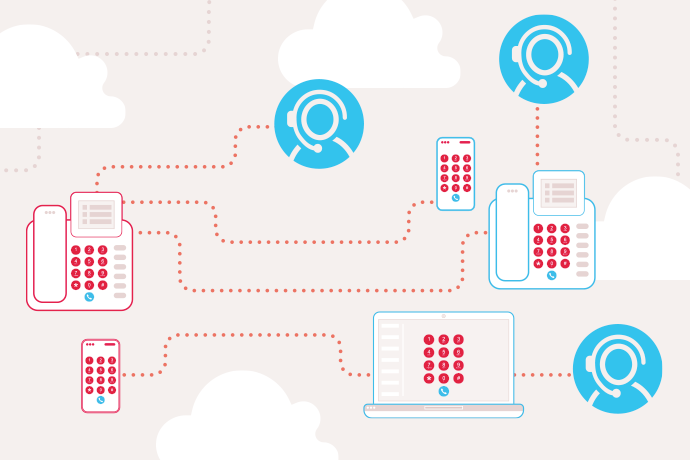Basket Total
£0.00
-
Your shopping basket is empty
Loading

Hello! Log in Your Account
New customer? Start here
inc VAT
ex VAT


|
5 min read
Contents
Quick Summary
Compare call route techniques and decide which one is the most appropriate solution for your teams.
As a business you have a variety of call routing strategies at your disposal to aid your goals of greater efficiency and improved customer experience.
Call routing can help enhance the productivity of your organisation, but it can be a little confusing choosing which call route strategy to implement. That's why we've whittled down our top 5 methods to start you off, and help you find the most appropriate solution to tackle your inbound calls.
This routing strategy sees incoming calls automatically diverted to the agent who has answered the fewest calls within a specified time period. Time period options range from 1 hour to 12 and 24 hours.
Other variations of this call routing strategy include distributing calls to the attendant who’s been talking for the least amount of time, or who’s been idle for the longest time period.
This strategy can be helpful for ensuring your agents all answer a similar number of calls or spend a similar amount of time on the phone. It also ensures that calls are answered in a timely fashion.
However, this strategy can mean that more specialised enquiries are dealt with by staff who may lack specific knowledge. As a result, enquiries could end up taking a little longer to deal with, although this isn’t a problem if all your agents are of a similar skill level.

A skills-based strategy is especially beneficial for the caller. Using an interactive call menu, the caller can select which department or service they need. This ensures that their query can be dealt with as efficiently as possible and by a dedicated team member.
Without calls being equally distributed, you may find certain departments receive higher call volumes which could be a disadvantage for smaller or highly specialised teams.
But with the right mix of agents, using Interactive Voice Response (IVR) menus in your call route can be extremely helpful way of reducing resolution times while successfully increasing customer satisfaction in your brand.

Geo-routing works by diverting calls to the relevant team based on the caller’s phone number area code.
This call route method is especially advantageous if your business contains regional, national or even international call handling teams.
For organisations that operate multi-language support or provide dedicated local services, location-based routing ensures your callers are treated with care wherever the most appropriate member of the team is located.

This is the most straight-forward of call routes. It simply sends incoming calls direct to a specified hunt group or phone extension.
There are slight variations available with this call route strategy where if the group or extension is busy the incoming call can be directed to a voicemail mailbox or put into a call queue for example.
For businesses that primarily make outgoing calls or who are just establishing themselves, this direct call routing strategy is easy to set up and works well for businesses that have several dedicated numbers for their teams or agents.

Using sequential call routing allows your teams to be as productive as possible. This strategy lets you prioritise the who receives the call first and then the order of subsequent call recipients if the call was unable to be answered by the initial call recipient.
Flowing calls in a sequential way lets specialised team members field calls first, unless they are unavailable, in which case other members of the team can pick up the call.
The positives of this strategy are that there is a high chance of calls being answered while your multi-skilled team can concentrate on any additional tasks that they have to hand.

Advancements in communication technologies have made smart call routing more attainable to businesses. Our intuitive Cloud-based phone system lets your business set up your call flows, rules and strategies in a matter of minutes. So, whether you’re an established or growing business, effective call distribution is firmly within your grasp.
Don’t forget if you’d like more advice on which call routing methods would be best with your business, don’t hesitate to get in touch with the team who are always happy to help.
Call routing can be described as the process of distributing phone calls to a specific destination based on a chosen criteria or set of rules.
In the Yay.com phone system, calls can be routed to your desired destination using the call route editor, which can be found in your online portal. Simply place routing modules within the call route to direct the call to your chosen outcome. Assign the call route to a phone number to make it active for inbound calls.
Call routing can improve the experience of your customers and clients. It can successfully stop your agents being overwhelmed by high call volumes. The right call routing method can also enhance productivity in the workplace by enabling teams to focus on their tasks at hand, while still supporting callers to the best of their ability.


AHT is key to improving customer satisfaction, but it is also important to strike a balance between efficiency and quality support to boost your business' potential
Posted 5 September 2024 | 7 min

As call volumes increase, a solution that automatically answers calls can prove valuable. We compare auto-attendants and virtual receptionists to find out the best option.
Posted 22 December 2023 | 5 min

Find out how warm transfers can help your teams appear more engaging, what the difference is between warm and cold transfers, and how our best practice tips can boost your caller satisfaction.
Posted 24 August 2023 | 7 min